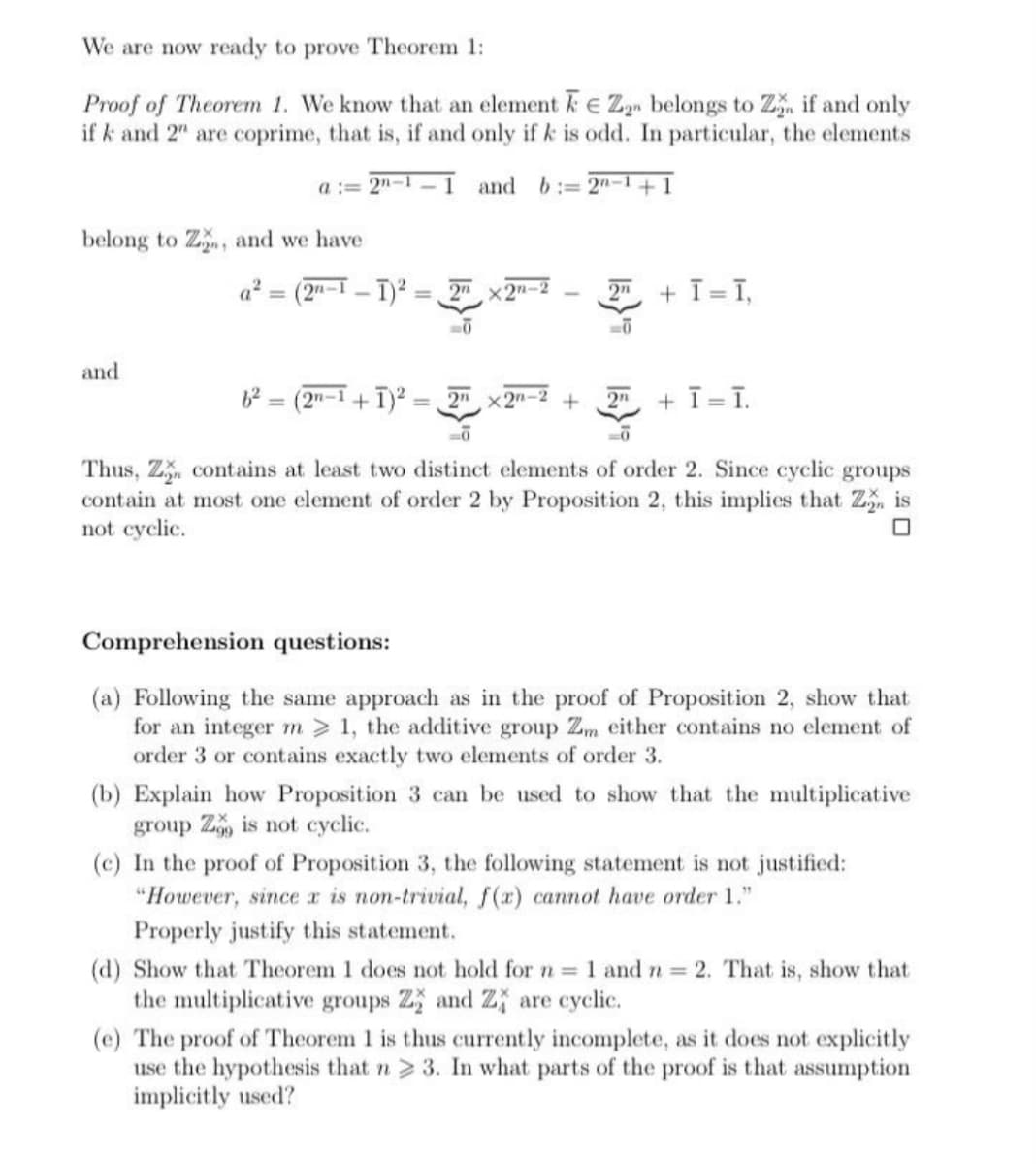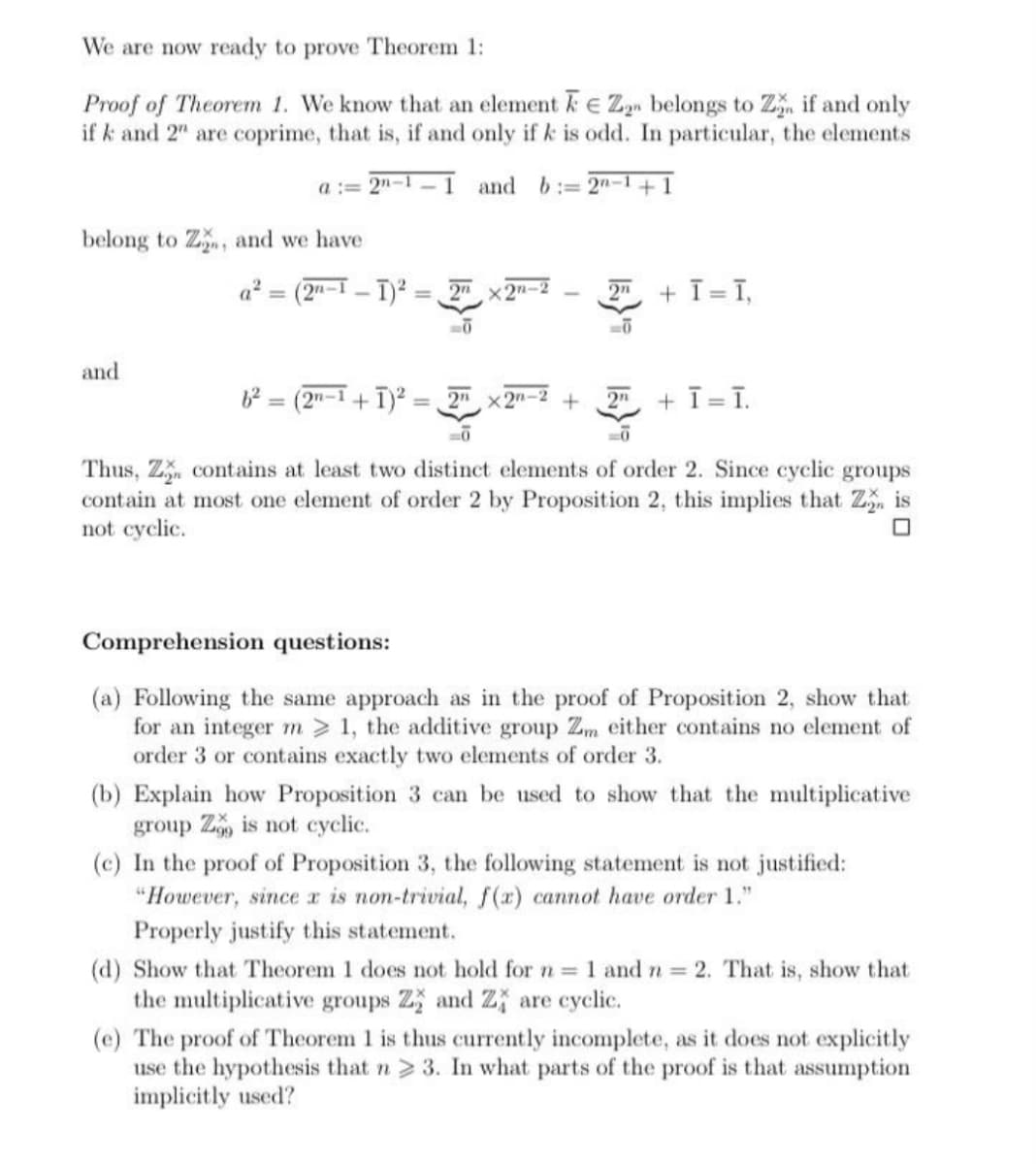(d) Show that Theorem 1 does not hold for n 1 and n = 2. That is, show that the multiplicative groups Z and Z are cyclic. (e) The proof of Theorem 1 is thus currently incomplete, as it does not explicitly use the hypothesis that n > 3. In what parts of the proof is that assumption implicitly used?
(d) Show that Theorem 1 does not hold for n 1 and n = 2. That is, show that the multiplicative groups Z and Z are cyclic. (e) The proof of Theorem 1 is thus currently incomplete, as it does not explicitly use the hypothesis that n > 3. In what parts of the proof is that assumption implicitly used?
Algebra & Trigonometry with Analytic Geometry
13th Edition
ISBN:9781133382119
Author:Swokowski
Publisher:Swokowski
Chapter10: Sequences, Series, And Probability
Section: Chapter Questions
Problem 63RE
Related questions
Question
please send handwritten solution for part d , e
only handwritten solution accepted

Transcribed Image Text:We are now ready to prove Theorem 1:
Proof of Theorem 1. We know that an element kEZn belongs to Z if and only
if k and 2" are coprime, that is, if and only ifk is odd. In particular, the elements
a := 2"-1 –1 and b := 2"-1+ 1
belong to Z, and we have
a² = (2"-I - T)² :
2n x2n-2
+ T = T,
%3D
%3D
2n
and
(2"-1+1)2:
+ ī = T.
2n x2n-:
2n
Thus, Z contains at least two distinct elements of order 2. Since cyclic groups
contain at most one element of order 2 by Proposition 2, this implies that Z is
not cyclic.
Comprehension questions:
(a) Following the same approach as in the proof of Proposition 2, show that
for an integer m > 1, the additive group Zm either contains no element of
order 3 or contains exactly two elements of order 3.
(b) Explain how Proposition 3 can be used to show that the multiplicative
group Z is not cyclic.
(c) In the proof of Proposition 3, the following statement is not justified:
"However, since r is non-trivial, f(x) cannot have order 1."
Properly justify this statement.
(d) Show that Theorem 1 does not hold for = 1 and n 2. That is, show that
the multiplicative groups Z and Z are cyclic.
(e) The proof of Theorem 1 is thus currently incomplete, as it does not explicitly
use the hypothesis that n > 3. In what parts of the proof is that assumption
implicitly used?

Transcribed Image Text:We are now ready to prove Theorem 1:
Proof of Theorem 1. We know that an element kEZn belongs to Z if and only
if k and 2" are coprime, that is, if and only ifk is odd. In particular, the elements
a := 2"-1 –1 and b := 2"-1+ 1
belong to Z, and we have
a² = (2"-I - T)² :
2n x2n-2
+ T = T,
%3D
%3D
2n
and
(2"-1+1)2:
+ ī = T.
2n x2n-:
2n
Thus, Z contains at least two distinct elements of order 2. Since cyclic groups
contain at most one element of order 2 by Proposition 2, this implies that Z is
not cyclic.
Comprehension questions:
(a) Following the same approach as in the proof of Proposition 2, show that
for an integer m > 1, the additive group Zm either contains no element of
order 3 or contains exactly two elements of order 3.
(b) Explain how Proposition 3 can be used to show that the multiplicative
group Z is not cyclic.
(c) In the proof of Proposition 3, the following statement is not justified:
"However, since r is non-trivial, f(x) cannot have order 1."
Properly justify this statement.
(d) Show that Theorem 1 does not hold for = 1 and n 2. That is, show that
the multiplicative groups Z and Z are cyclic.
(e) The proof of Theorem 1 is thus currently incomplete, as it does not explicitly
use the hypothesis that n > 3. In what parts of the proof is that assumption
implicitly used?
Expert Solution
This question has been solved!
Explore an expertly crafted, step-by-step solution for a thorough understanding of key concepts.
Step by step
Solved in 3 steps with 3 images

Recommended textbooks for you

Algebra & Trigonometry with Analytic Geometry
Algebra
ISBN:
9781133382119
Author:
Swokowski
Publisher:
Cengage

Linear Algebra: A Modern Introduction
Algebra
ISBN:
9781285463247
Author:
David Poole
Publisher:
Cengage Learning

Elements Of Modern Algebra
Algebra
ISBN:
9781285463230
Author:
Gilbert, Linda, Jimmie
Publisher:
Cengage Learning,

Algebra & Trigonometry with Analytic Geometry
Algebra
ISBN:
9781133382119
Author:
Swokowski
Publisher:
Cengage

Linear Algebra: A Modern Introduction
Algebra
ISBN:
9781285463247
Author:
David Poole
Publisher:
Cengage Learning

Elements Of Modern Algebra
Algebra
ISBN:
9781285463230
Author:
Gilbert, Linda, Jimmie
Publisher:
Cengage Learning,
